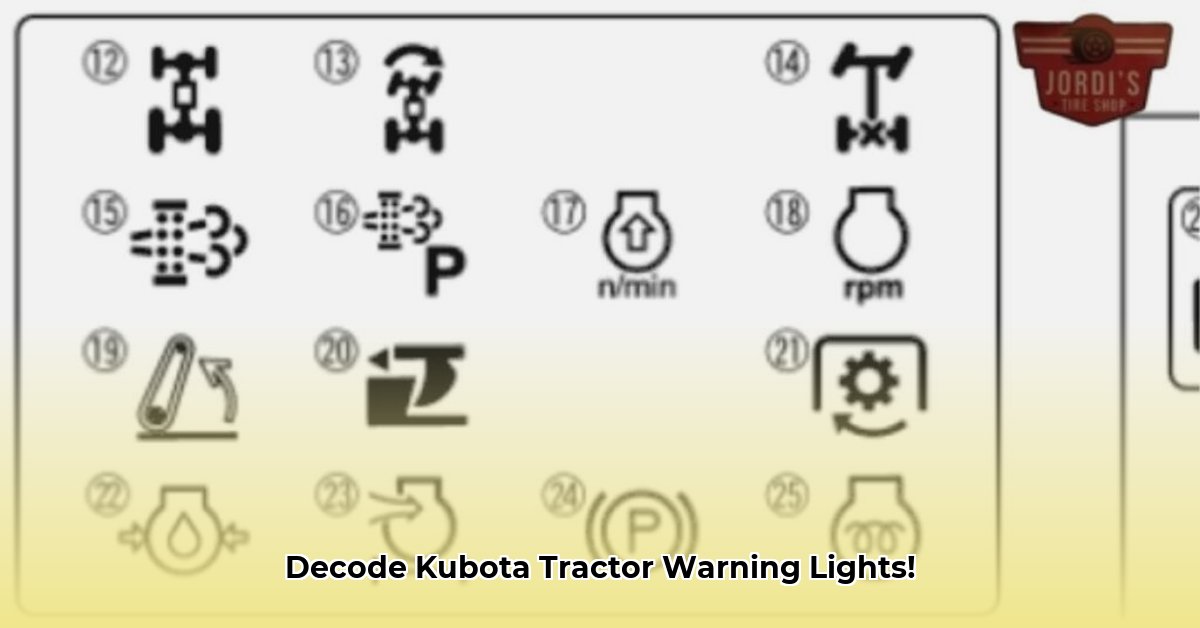
Understanding Your Kubota Tractor's Warning System: A Preventative Maintenance Guide
Your Kubota tractor's dashboard isn't just a collection of lights and gauges; it's a vital communication system designed to protect both you and your machine. Understanding these signals is crucial for preventing costly repairs and ensuring safe operation. Ignoring warning lights can lead to serious damage or even injury. This guide will help you decipher your tractor's messages and proactively maintain its health. Remember, this guide supplements, but does not replace, your owner's manual. Always consult your owner's manual for model-specific details. For more on overheating, see this helpful resource: Kubota Overheating Guide.
Decoding Your Dashboard: A Visual Guide to Kubota Tractor Warning Lights
This section would ideally include high-quality images of Kubota tractor dashboards with each indicator clearly labeled and numbered. Since visual aids are not possible here, we'll provide detailed descriptions. Imagine a panel filled with gauges and lights, each crucial for monitoring your tractor's health.
Common Dashboard Indicators and Their Meanings
The following table outlines typical warning lights and gauges found on many Kubota tractors. However, keep in mind that your specific model may have additional lights or slight variations in symbols. Always refer to your owner's manual for complete accuracy.
| Symbol/Indicator | Meaning | Action Required |
|---|---|---|
| Engine Temperature Gauge (Thermometer) | Displays engine temperature. Ideal range is indicated on the gauge. | If needle enters the red zone (overheating), shut down immediately. Let cool completely before investigating. Consistently low readings also require attention. |
| Oil Pressure Warning Light (Red Oil Can) | Indicates low oil pressure, critical for engine lubrication. | This is urgent! Shut down immediately. Check oil level; add correct type if low. If the light persists, seek professional assistance. |
| Fuel Level Indicator (Fuel Pump) | Shows remaining fuel. | Refill when nearing empty. Running out of fuel can damage the engine. |
| Battery Warning Light (Battery Symbol) | Indicates a problem with the battery or charging system. | Check battery terminals for corrosion and tightness. Professional help is likely needed if the problem continues. |
| 4WD Engagement Light (4x4 Symbol) | Shows whether four-wheel drive is engaged. | Ensure it's engaged when needed for optimal traction; disengage when not needed to reduce wear. |
| PTO Engagement Light (PTO Symbol) | Indicates the Power Take-Off (PTO) – the system powering attachments – is running. | Only engage when necessary and attachments are securely connected. Never work near a spinning PTO. |
| Air Cleaner Restriction Light (Filter Symbol) | Indicates a clogged air filter, restricting engine airflow. | Clean or replace the air filter promptly. Restricted airflow damages the engine. Consult your owner's manual for proper procedures. |
| Parking Brake Indicator (Parking Brake Symbol) | Indicates whether the parking brake is engaged. | Always release the parking brake before operating the tractor. |
Interpreting Warning Light Behavior: Steady vs. Flashing
A steadily lit light usually suggests a problem requiring attention, while a flashing light indicates a critical issue demanding immediate action. A steadily lit engine temperature light might mean the engine is running warm, allowing for monitoring and potential adjustments. However, a flashing light demands immediate shutdown to prevent damage. Always consult your owner's manual for specific interpretations.
When Professional Help is Necessary
While some issues, like a low fuel warning, are easily addressed, others require professional expertise. Attempting complex repairs yourself can worsen the problem and may result in injury or further damage. Seek professional help if:
- Critical Issues: Flashing warning lights (especially oil pressure, engine temperature), sudden power loss, unusual engine noises, or smoke.
- Beyond Your Skills: Any repair outside your expertise or comfort zone.
- Safety First: If uncertain about a problem, it is best to err on the side of caution. A mechanic can provide an accurate diagnosis and necessary repairs.
Preventative maintenance is vital for extending your Kubota's lifespan and avoiding costly repairs. Regular checks, fluid changes, and prompt attention to warning signals are crucial. Ignoring these signals can result in significant problems and downtime.
Kubota Tractor Dashboard Warning Lights: Model-Specific Variations
Understanding your Kubota tractor's warning lights is key to preventing issues and staying safe. Kubota often uses a color-coded system:
- Red: Critical – Immediate action is needed! Shut down immediately and investigate.
- Amber: Serious – Address promptly; continued operation may cause damage.
- Green: Normal operation.
- Blue: Emissions-related; usually requires attention, but not immediate shutdown.
This is a general guideline. Always refer to your owner's manual for precise interpretations as variations exist between models. The owner's manual will detail how to interpret Kubota tractor dashboard warning lights for specific model variations.
Common Warning Lights and Their Meanings (Examples)
| Warning Light | Color | Meaning | Action |
|---|---|---|---|
| Engine Malfunction | Red | Critical engine failure. | Shut down immediately. Contact a qualified mechanic. |
| Low Oil Pressure | Red | Insufficient lubrication; imminent engine damage. | Immediate shutdown; check oil level. Do not restart until resolved. |
| Low Fuel | Amber | Low fuel level. | Refuel immediately. |
| Check Engine | Amber | Problem detected by the engine's computer system. | Consult your owner's manual; may require professional attention. |
| Temperature Warning | Red | Engine overheating. | Immediate shutdown; let engine cool completely; check coolant levels. |
| 4WD/Differential Lock | Amber | Problem with 4WD or differential lock engagement. | Investigate engagement mechanisms; professional help might be needed. |
| PTO Warning | Amber | Problem with the Power Take-Off (PTO) system. | Do not operate the PTO; seek professional assistance. |
Crucial Considerations:
- This guide provides general information. Your owner's manual contains model-specific details.
- Ignoring warning lights can lead to serious damage and injury. Prioritize safety.
- Regular maintenance significantly reduces the likelihood of many warning light issues.